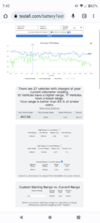For comparisons in range / supercharging use, you should also ensure that you are comparing the same battery chemistry as well - older S and X have Li-ion, newer 3 and Y (and possibly refresh S/X) have Lithium Iron Phosphate (LFP) batteries. The profiles and degradations will be different.
Model S and X has Panasonic 18650 format lithium ion of the NCA chemistry, Model 3 LR/P and Y LR /P in USA use Panasonic 21700 still NCA.
In Europe it was the same for model 3 until about 2022.
Model 3 SR did use Pansonic NCA earlier but changed over about 2021 to LFP.
The only cars using LFP is standard range cars (now "SR" is removed), this is because LFP cannot provide tha range of a LR car (to little space, and they would be heavy).
Of course the chemistry is taken in account when discussing degradation for either calendar aging or cyclic aging.
This is on the aged battery in the X. 400V Lithium Ion, 90kw rating (so 81.8 original usable)
I dont have the Xnumbers, but for reference:
When using the Tessie App (or service), the term "usable" should not be taken any notice of, as Tessie calculate the whole battery capacity.
The value inside the "meter" should be the total capacity (not "Net", not "usable" but the complete whole capacity). This is because Tessie calculates the "usable capacity" as the total capacity including the buffer. I doesnt sound like they should, if we think of the term used, but the vendors confirmed this in the vendors thread and when checking with Scan My Tesla on the same vehicle, nominal full oack is the closest value, In some cases the calculation even match, so Tessie have some bright occations also. But they should stop calling it "usable" as it really isnt according to the common accepted interpretation of the term [usable] in combination with EV batteries and buffers.
So in the end, in the meter the whole original capacity need tpo be used (including the buffer) as the degradation calc is built on the "usable capacity" using the total capacity including the buffer.
If not doing this correct, and using the tessie like tessie does imly, my car has 78.9 kWh usable capacity (which would be 82.6 including the 4.5% buffer) out of a initial capacity of 78.8 kWh (as tessie thinks my model* has. So, today after 2yrs 4 months and 61K km, Im at 3.8kWh
plus (increased capacity) from the start.
Thats good, Ill will pass 100kWh usable in a few years.

IRL, I'm at 78.9kWh of 82.1 kWh total capacity.





